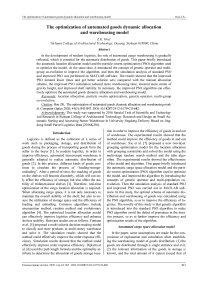The optimization of automated goods dynamic allocation and warehousing model
Автор: Hou Zhongkun
Журнал: Компьютерная оптика @computer-optics
Рубрика: Численные методы и анализ данных
Статья в выпуске: 5 т.44, 2020 года.
Бесплатный доступ
In the development of modern logistics, the role of automated cargo warehousing is gradually reflected, which is essential for the automatic distribution of goods. This paper briefly introduced the automatic location allocation model and the particle swarm optimization (PSO) algorithm used to optimize the model. At the same time, it introduced the concept of genetic operator and multi-group co-evolution to improve the algorithm, and then the simulation analysis of standard PSO and improved PSO was performed on MATLAB software. The results showed that the improved PSO iterated fewer times and get better solution sets; compared with the manual allocation scheme, the improved PSO calculation reduced more warehousing time, lowered more center of gravity height, and improved shelf stability. In summary, the improved PSO algorithm can effectively optimize the automated goods dynamic allocation and warehousing model.
Location allocation, particle swarm optimization, genetic operator, multi-group co-evolution
Короткий адрес: https://sciup.org/140250056
IDR: 140250056 | DOI: 10.18287/2412-6179-CO-682
Список литературы The optimization of automated goods dynamic allocation and warehousing model
- Petering M. Real-time container storage location assignment at an RTG-based seaport container transshipment terminal: Problem description, control system, simulation model, and penalty scheme experimentation. Flex Serv Manuf J 2015; 27(2-3): 351-381.
- Yang CL, Nguyen TPQ. Constrained clustering method for class-based storage location assignment in warehouse. Ind Manag Data Syst 2016; 116(4): 667-689.
- Saboori H, Hemmati R. Optimal management and planning of storage systems based on particle swarm optimization technique. J Renew Sust Energ 2016; 8(2): 453-475.
- Tsamis N, Giannikas V, Mcfarlane D, Lu W, Strachan J. Adaptive storage location assignment for warehouses using intelligent products. Nat Commun 2015; 6(1): 271-279.
- Fontana ME, Nepomuceno VS. Multi-criteria approach for products classification and their storage location assignment. Int J Adv Manuf Technol 2016; 88(9-12): 1-12.
- Dijkstra AS, Roodbergen KJ. Exact route-length formulas and a storage location assignment heuristic for picker-to-parts warehouses. Transp Res E Logist Transp Rev 2017; 102: 38-59.
- Xie J, Mei Y, Ernst A T, Li X, Song A. A Bi-level optimization model for grouping constrained storage location assignment problems. IEEE Trans Cybern 2018; 48(1): 385-398.
- Saboori H, Hemmati R. Optimal management and planning of storage systems based on particle swarm optimization technique. J Renew Sust Energ 2016; 8(2): 453-475.
- Chen Z, Li X, Lv B, Jia M. A self-adaptive wireless sensor network coverage method for intrusion tolerance based on particle swarm optimization and cuckoo search. IEEE Trustcom/BigDataSE/ISPA 2015; 1: 1298-1305.
- Yang P, Miao L, Xue Z, Ye B. Variable neighborhood search heuristic for storage location assignment and storage/retrieval scheduling under shared storage in multi-shuttle automated storage/retrieval systems. Transp Res E Logist Transp Rev 2015; 79: 164-177.
- Joly M, Rocha R, Sousa LCF, Takahashi MT, Mendonça PN, Moraes LAM, Quelhas AD. The strategic importance of teaching Operations Research for achieving high performance in the petroleum refining business. Educ Chem Eng 2015; 10: 1-19.
- Azaza M, Wallin F. Multi objective particle swarm optimization of hybrid micro-grid system: A case study in Sweden. Energy 2017; 123: 108-118.
- Pan I, Das S. Fractional order AGC for distributed energy resources using robust optimization. IEEE Trans Smart Grid 2016; 7(5): 2175-2186.
- Mohanasundaram R, Periasamy PS. Clustering based optimal data storage strategy using hybrid swarm intelligence in WSN. Wirel Pers Commun 2015; 85(3): 1381-1397.


